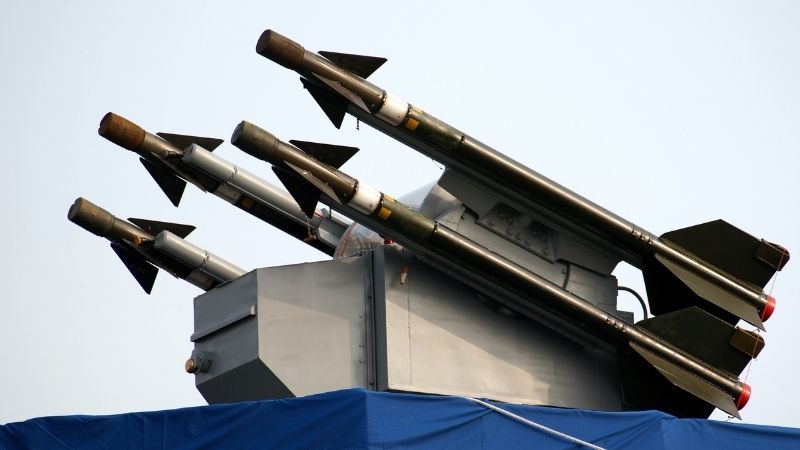What is the Difference Between a Missile and a Rocket?
Rockets and missiles are two words that are frequently used interchangeably. Personally, I tend to use “missile” in a military context and “rocket” for space exploration. But what’s the real difference?
As a whole, rocket are short-range weapons because they can’t be guided after launch. On the other hand, missiles include a navigation system and a second engine to adjust the direction after launch. Therefore, missiles are preferred for long-range attacks.
Obviously, this is a short answer for your question, and there are more details to know about each type of weapon. Keep reading to discover all the secrets on how they work.
Main Difference Between Rockets and Missiles
Both rockets and missiles were designed to carry explosives to a target. The main difference is that missiles have a guidance system to assist them in meeting their designated target. Rockets, however, do not have a guidance system and are simply launched in the direction of the primary target.
Some would say that missiles have brains and rockets are brainless.

Although the direction of the target is highly calculated for both missiles and rockets, due to the in-built guidance system, missiles will have a better chance of achieving their target than rockets do.
In military terminology, a missile might also be called a “guided rocket”. Missiles are fairly advanced technology and have numerous elements that are built-in together to make up, or rather produce, a missile.
Even though rockets and missiles primarily look the same on the outside and ultimately have been designed with the same goal in mind to deliver warheads to enemy targets, they are not the same in the way they are engineered and have numerous differences.
Rockets
When the first rockets were designed and used in China against the Mongols in 1232, nobody knew exactly how advanced rockets would become. Nor did they know the destruction, evolution, and advancements rockets would have on our society today.
Rockets have been used in wars for centuries. Becoming outdated by the 15th century, then reintroduced years later as developed weaponry for military advancements and, of course, for space awareness and innovations.
Today, rockets are used in multiple instances such as firework displays, weaponry, and space exploration. Rockets have literally changed the way we look at the world. For instance, although there has been indirect knowledge since as early as 500B.C of the earth being round, sounding rockets were able to provide us earthlings with photographic evidence of the earth’s spherical shape.
You should also read: The 6 Differences Between Space And Universe (With table)
How are rockets powered?
Rockets are powered by rocket engines. A rocket engine uses what’s called stored reaction mass to form a high-speed jet of fluid for the rocket’s acceleration. Rockets can be used to thrust or propel spacecraft and ballistic missiles.
This video will explain this in more detail if you are interested in this topic:
Types of Rockets
Since their introduction to the world in the 13th century, rockets have evolved and changed as technology has progressed. Mankind has advanced its weaponry to match the modern-day era of military battle and war.
Here is a list of the types of rockets used today as weapons:
· Rocket Launchers (Bazooka/RPG)
Rocket launchers are a type of readily carried firearm that designated soldiers will use in the combat zone. The rocket launcher is a shoulder-fired weapon, also known to be used as an anti-tank weapon.
· Rocket Pod
A rocket Pod consists of multiple rocket launchers that are designed to be used by aircrafts for airstrike assaults.
· Rocket Artillery
For large-scale attacks, rocket artillery was constructed. Also called a missile tank, the rockets fired from tanks are only guided by the soldier operating the tank’s artillery machinery. The artillery (rocket) itself does not have in-built guidance or target systems and is therefore not technically a missile.
Missiles
Missiles are designed to carry explosives, with control and precision, to a designated target and at high speeds. Missiles are rocket-propelled weapons but because of their enhanced built-in technology, they are far more advanced than rockets for military uses.
Missiles were developed and manufactured by the Germans in World War 2. They are controlled by wireless remote controls and are only used for military purposes, as opposed to rockets that are used for entertainment, space travel, military uses, and more.
5 systems make up a guided rocket, otherwise known as a missile. They are as follows:
· Guidance System.
The guided system in a missile is used to adjust and stabilize the flight path. An operator, or pilot, guides the missile to the intended target to ensure superior accuracy.
· Warhead.
The warhead part of the missile is the bomb. It can be explosive or toxic, either way, it is delivered by the missile to an exact target location for the explosion.
The warhead can be detonated by several options, depending on how the missile was designed. From physical target detonation to remote detonation operated by a military service member, among other options that you can read more about here.
· Engine.
Missiles are designed to be powered by a type of engine, usually a rocket engine or in some cases, a jet engine.
· Flight System.
The flight system works with the targeting and/or guidance system to account for possible maneuvers and necessary changes to the flight path.
· Targeting System.
Target accuracy is critical to the missile doing what it was designed to do. The targeting system and the guidance system work together with radars and satellites, to determine the target and fly the missile truly to its mark.
What Types of Missiles are There?
There are multiple types of missiles used for military purposes, and each of these missile types has various other missiles listed under them. You can see all of them here for further information.

Here are the three types of missiles used in the military:
· Guided Missiles
A self-propelled, airborne weapon, typically used for short-range fire within the immediate battle zone.
· Cruise Missiles (Strategic)
Cruise missiles are long-range missiles. They carry warheads over vast distances, with the assistance of their in-built guided system. These self-navigating missiles fly through the air at supersonic speeds, can fly at low altitudes, and are self-navigating.
· Ballistic Missiles (Strategic)
Most of the ballistic missile’s flight is not guided and is unpowered. Ballistic missiles have three main parts, the powered, free-flight, and re-entry. Yes, re-entry. Generally, most ballistic missiles are designed to exit the earth’s atmosphere at an angle that allows the missile to re-enter and ‘fall’ towards its target.
Ballistic miles are typically designed for extremely long ranges. Some ballistic missiles that have been designed do not exit the earth’s atmosphere and involve the first two parts of the ballistic system (Powered and free flight).
Rocket VS Missile
Here is a quick guide to the differences and similarities you would typically find between rockets and missiles.
| Rocket | Missile |
| Self-propelled | Guidance system for target accuracy |
| Unguided | Navigation system |
| Target is acquired before launch, alterations cannot be made. | Target accuracy with operator control |
| Typically for short Short-range with smaller designs for combat use. | Long-range and short-range types |
| Cannot change directions after being fired | Can change directions mid-flight to ensure the target is achieved. |
| Carries explosive warheads | Carries explosive warheads |
| Propelled by a rocket engine | Propelled by a rocket engine and a jet engine |
Frequently Asked Questions (FAQ)
Have more questions about missiles and rockets? No stress, we might be able to answer them for you. Take a look at our frequently asked questions here.
Are spaceships a type of rocket?
Rockets work with spacecraft technology to propel rocket ships into space. Rockets and spacecraft together are what make a rocket ship, or a spaceship.
With initial guidance during takeoff, the rocket is then launched, with the spacecraft technology, into space with a calculated target that the rocket ship is aiming for. This is usually straight up into the sky, the outer orbit and space craft technology tend to do the rest when the rocket makes it past the earth’s atmosphere.
Click on the link to learn more about the differences between a rocket and a spaceship.
Are rockets still used in weaponry today?
Although rockets have advanced us to outer space and can send space crafts to the moon, rockets are still used as weapons today.
Rockets are still useful for short-range attacks, particularly for close air support (CAS) missions.
Do all missiles use rocket engines?
No, not all missiles use rocket engines. Missiles are also designed to use jet engines.
Are torpedo’s rockets or missiles?
Torpedoes are underwater guided missiles. Typically, missiles are launched into and through the air. Their torpedo design is launched for underwater attacks but is also, in today’s modern world, typically guided.






